Political Unrest and Artists: The Great Depression

After writing the blogs about the American artist Lee Krasner and learning about her ability to survive through personal problems but also through The Great Depression, I started thinking about the effects of politcal uncertainty on artists.
I was totally unaware of the measures President Roosevelt took to use the arts and artists to help combat the effects of economic turmoil. You can read more about this in the blogs on Lee Krasner.
I am not in any way suggesting that artists are more special than the rest of the population but it is predictable that when a country faces an uncertain economic future the creative arts are amongst the first to suffer.
At the moment, two of the greatest nations on earth, America and Great Britain, are experiencing severe political challenges, the effects of which could be comparable to the situation which led up to the Great Depression, affecting the world for a decade in the 1930s.
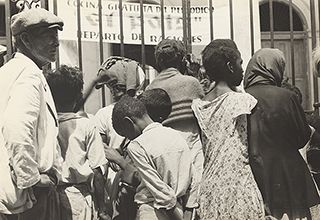
The image above is of a breadline in Cuba, showing us the effect of the Great Depression on other nations. People line up against a fence, where a sign reads: “Cocina gratuita de Periodico, Departo de Raciones” (Temporary Free Kitchen, Ration Distribution).
Walker Evans went to Cuba in 1933, but not to document the effects of the Depression. He was on assignment to take photographs for a book entitled The Crime of Cuba. The book was a critique of the regime of President Gerardo Machado y Morales, in office from 1925 to 1933. As the Depression was felt in Cuba, Machado’s regime became increasingly repressive, which fostered civil unrest. He was overthrown with assistance from the United States shortly after The Crime of Cuba was published. Machado was succeeded by Fulgencio Batista who was, in turn, overthrown by Fidel Castro in 1956. (nga.gov)
The National Gallery of Art in Washington has a collection which contains many examples of works of art from this period of history.
The art offers a window through which to explore the social conditions of the Depression, the mainstreaming of art and birth of “public art,” and the opening of government employment to women and African Americans. (nga.gov)
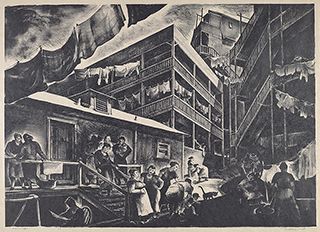
Family flats were houses and buildings divided by a landlord into small apartments, often overcrowded and in poor condition, and were also known as tenements. Such housing was frequently the only option for poor families.
The place shown here is Millard Sheets’s native Los Angeles, in a neighborhood that no longer exists called Bunker Hill. You can get a sense of the pitched topography as the buildings at the top of the image rise quite high above the figures at the very bottom of the frame. It is laundry day and groups of women chat, do their wash using buckets (at right), and hang clothes on the swinging lines that crisscross the picture.
Try to count the number of clotheslines and then the number of other diagonal forms. Name each type of diagonal you see (e.g., roofline, railing, stair). How do the diagonals create a sense of activity and movement? Imagine if the lines were all perpendicular or parallel. How would the scene be different? Try to draw a sketch of the scene replacing the diagonals with perpendicular or parallel lines. See the Pinterest board for a painting of this same scene that Sheets painted in 1934, upon which he based this print. (nga.gov)
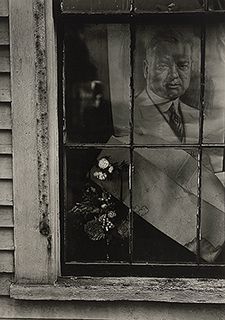
Walker Evans had a keen eye for the telling detail. He photographed this weathered window featuring a poster for presidential candidate Herbert Hoover.
Hoover ran for and won the presidency in 1928, elected on the strength of his successful work to alleviate hunger in Europe after World War I. If you look closely, you can make out the “-er” of “Hoover” on the poster, which is no longer proudly displayed, but rather folded like origami and stained at the bottom. Its state seems to presage President Hoover’s sinking reputation once the Depression was underway, although Evans could not have known this in 1929. A small, faded flower arrangement on the sill reinforces the impression of a loss of hope and time moving on. (nga.gov)
The Great Depression affected everybody and not only people living in the cities. The two images below are a stark reminder of the disastrous effect of this period in history on the rural community. This is also a strong reminder how tenuous is the relationship between rural life- open to the life threatening effects of environmental changes such as drought - and political stability.
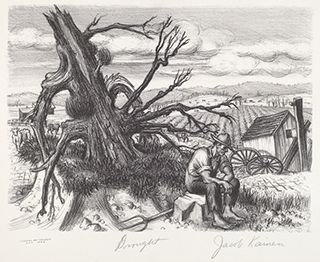
Many artists created images that addressed the environmental devastation that occurred during the Depression. The effects of the bad economy were magnified for agricultural workers and American Indians living on reservations, whose Native lands were overgrazed by livestock permitted there by federal rules, and vulnerable to erosion.
In Jacob Kainen’s work, what signs do you see in the picture that offer clues to the state of the environment? You may notice the farmer’s downcast appearance as well as the twisted, dead tree, sandy-looking soil, bony livestock, and sparse vegetation in the fields. Discarded wagon wheels may indicate there is nothing to harvest or transport. (nga.gov)
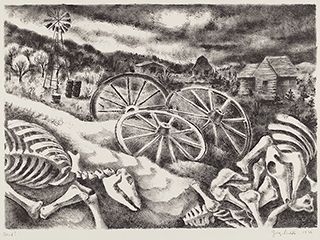
The imagery in Biddle’s Sand! and Kainen’s Drought is similar.
Notice the placement of the horizon line, gathering storm or dust clouds, and the use of the wagon wheel motif, which may symbolize the halt of progress and inability to move on from difficulties.
Biddle’s work offers more explicit imagery—suggesting the bones of domestic livestock that withered from starvation. Biddle studied the art of Mexican muralists who frequently used death imagery and Sand! may reflect their influence. Biddle was also instrumental in advising Franklin Delano Roosevelt to start a program paying unemployed artists a living wage to create images reflecting aspects of American life, which eventually became the Federal Art Program. (nga.gov)
At the time of writing this blog in early October 2019 Australia has already experienced several devastating bushfires resulting in loss of life- an ominous warning considering our worst bushfire season is usually in late summer.
Drought is affecting much of Australia.
About 99 percent of New South Wales – which accounts for a quarter of Australia’s agricultural output by value – is now officially in drought.(reuters.com)
If you would like to view more of these remarkable images from this period in history please follow this link to read more about Art and the Great Depression.
Today's blog is only a teaser for us to learn more about Artists in Times of Political Turmoil. Expect more blogs on this topic and if you have an interest in this area please send in your ideas.
